Diverse Tile Patterns to Elevate Kitchen Design
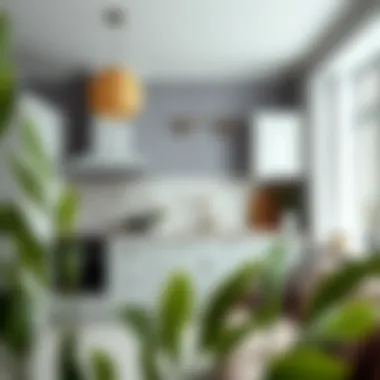

Intro
When it comes to designing a kitchen, the choices can be overwhelming. Yet, one element stands out among the rest and can truly transform the space: tiles. Tiles not only serve the practical purpose of protecting walls and surfaces but also add character and a splash of style to any kitchen setting. As the heart of most homes, the kitchen often becomes a gathering place for family and friends. Therefore, it is crucial to create an inviting and aesthetically pleasing space. This article will dive into various tile patterns that not only enhance the visual appeal of kitchens but also incorporate functionality and the latest trends.
Understanding how to choose tile patterns can be a daunting task. However, taking a few key points into account, such as trending styles, color palettes, and maintenance will significantly simplify the process. Each section below aims to equip homeowners and interior design enthusiasts with insights that can guide their decisions when choosing tiles for their kitchens. Let’s gather some inspiration and make that kitchen shine!
Design Inspirations
Trending Styles
Today’s kitchen design sees a medley of styles reflecting both traditional and contemporary influences. Each trend offers unique characteristics that can cater to different tastes and preferences.
- Subway Tiles: A classic choice, subway tiles are versatile and timeless. They can be arranged in stunning patterns, such as herringbone or stacked, adding depth to the kitchen.
- Mosaic Tiles: Adorned with vivid patterns or intricate designs, mosaic tiles allow for personalization in a kitchen setting. They can serve as both a backsplash and a decorative accent.
- Geometric Patterns: Sharp lines and bold shapes define the modern geometric style. These patterns can be eye-catching and create a focal point in the kitchen.
- Natural Stone Tiles: Suggesting a connection to nature, stone tiles provide an earthy feel. From slate to travertine, their unique textures can bring warmth and character to the room.
Color Palettes
Selecting the right color for tiles is just as essential as the style. The color palette can set the mood of the space, and here are some popular choices:
- Neutral Tones: Shades like beige, gray, or white create a serene backdrop and can easily be paired with other colors. They are ideal for a minimalist approach, meeting functionality with elegance.
- Bold Colors: Deep blues, rich greens, or vibrant yellows can energize a kitchen. Using these hues in patterned tiles can create striking visual interest.
- Pastels: Soft pinks and light blues can provide a calming, retro vibe. They work well in combination with vintage styles, providing nostalgia without sacrificing modernity.
- Monochrome: Black and white tiles can go a long way in creating a sophisticated and stylish kitchen. Patterns such as chevron or checkerboard can add flair without overwhelming the senses.
As you consider tile patterns for your kitchen, remember that blending styles and colors can lead to unexpected yet delightful results.
"The right tile pattern not only enhances the beauty of a kitchen but also impacts its functionality. Finding a balance is the key!"
In the following sections, we will explore how to maintain your tile selections, ensuring they stay pristine and complement your culinary space for years to come.
Prolusion to Kitchen Tile Patterns
The kitchen is the heart of the home, a gathering place for family and friends. The design choices made in this space, particularly regarding tile patterns, influence not only the aesthetic appeal but also the functionality of the kitchen. When diving into the world of kitchen tile patterns, you discover a myriad of options that range from classic to contemporary, each telling its own design story and serving various practical needs.
Embracing the art of tile patterns is vital for a few reasons. First, it can elevate the overall look and feel of your kitchen environment, transforming a simple cooking space into a welcoming hub. A well-chosen tile pattern can make your kitchen appear more spacious or create a cozy nook, depending on how you design and arrange the tiles.
Additionally, certain tile patterns offer benefits beyond visual appeal. For instance, some patterns can hide dirt and wear better than others, making them perfect for high-traffic areas. Subway tile, with its traditional rectangular shape, not only provides versatility but also hides smudges effectively due to its larger grout lines. In contrast, a herringbone pattern adds dynamic flair but may require more maintenance due to the intricate layout.
Considerations for choosing tile patterns should include material durability, ease of cleaning, and the overall kitchen theme. For instance, a rustic farmhouse kitchen might benefit from textured, natural stone tiles, while a sleek, modern kitchen would look stunning with glossy glass tiles. Mixing and matching different materials and patterns can also yield unique results.
Ultimately, discovering the right tile pattern can enhance the comfort, style, and functionality of your kitchen. This section aims to serve as a springboard into the broader discussion about tile patterns, guiding readers through various options and inspiring them to make thoughtful choices in their own kitchen design.
"A well-tiled kitchen often speaks a silent but dramatic language that can elevate mundane cooking into an art form."
By exploring tile patterns in detail, this article will illuminate the path to crafting beautiful, practical, and inspiring kitchen environments.
The Role of Tile in Kitchen Design
When it comes to kitchen design, tiles are more than just a decorative touch; they are strategically vital components. The significance of tiles stretches far beyond their visual appeal, impacting everything from functionality to maintenance. Therefore, understanding the role of tile in kitchen design becomes critical for homeowners and design enthusiasts alike.
Aesthetic Appeal
Tiles provide an expansive canvas for creativity, allowing for an array of colors, patterns, and textures. Just think about the way a beautiful mosaic or a sleek subway tile can transform an ordinary wall into a striking focal point. Consider the herringbone pattern; it adds a sense of movement and sophistication, turning a mundane backsplash into a work of art. Similarly, earthy tones in a natural stone tile can bring warmth and a rustic vibe to the space. Aesthetics aside, the choice of tile can also create a seamless flow between the kitchen and adjacent living areas, which is particularly important in open-concept layouts.
Durability and Functionality
Aside from their beauty, tiles are practical as well. Kitchen environments can be messy, with splatters and spills being par for the course. That’s where tiles shine — they are often moisture-resistant and easily wipeable, making them a smart choice for backsplashes and flooring. Ceramic and porcelain tiles, in particular, are renowned for their durability and ability to withstand heavy foot traffic. And let’s not forget about heat resistance; what better material to have nearby the stovetop than tiles that can endure high temperatures?
Health Considerations
The role of tile also intersects with health aspects. For instance, certain materials can impede the growth of mold or bacteria, which is an essential consideration in high-humidity areas like kitchens. Tiles don’t trap dust or allergens, making them a fantastic option for maintaining a clean environment, especially if you're often hosting family or friends for gatherings. If you opt for glass tiles, you not only have a stylish choice but also one that deflects dirt and grime more easily than other materials.
Easy Maintenance
Let’s talk about upkeep. When selecting tiles, homeowners should prioritize materials that require minimal maintenance and offer longevity. Vinyl tiles, for instance, don't need a lot of fuss; a quick mop down can often do the trick. Moreover, many tiles are now available with stains and scratches resistant finishings, further simplifying the cleaning process.
"The choice of tile resonates well beyond the kitchen design's aesthetics; it influences functionality, maintenance, and even health."
Cost Considerations
In terms of budget, the costs associated with tile can range widely. While high-end natural stone might give your space a luxurious flair, there are plenty of options that balance cost with style, like laminate and vinyl tiles which are budget-friendly but still visually appealing. In this way, understanding the role of tile also involves financial considerations that help determine what fits within your renovation budget.
Closure
When designing a kitchen, the choice of tile matters far more than meets the eye. It serves multiple roles; from enhancing aesthetic appeal to offering durability, ease of maintenance, and health benefits. Every homeowner and design enthusiast should approach tile selection with a well-rounded understanding of how it fits into the larger picture of kitchen design. This understanding not only helps in creating a functional space but also ensures that every tile laid brings value to the kitchen's overall aesthetic and functionality.
For further insights on improving your kitchen space, check out Wikipedia or visit Britannica's Kitchen Design for more detailed information.
Understanding Different Tile Materials
When contemplating the design of a kitchen, understanding tile materials is a crucial step in achieving the final look and feel of the space. Each material offers unique characteristics that affect not only aesthetics but also durability, maintenance, and functionality. Choosing the right tile can enhance the kitchen’s functionality while ensuring it adds to the overall style and warmth of your home. Here’s a closer look at some popular materials:
Ceramic Tiles
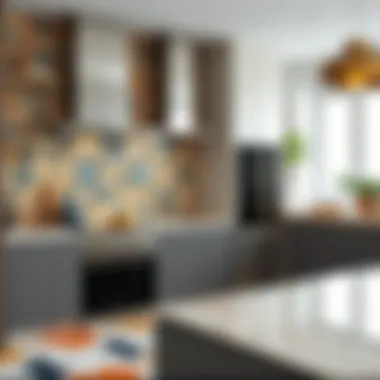
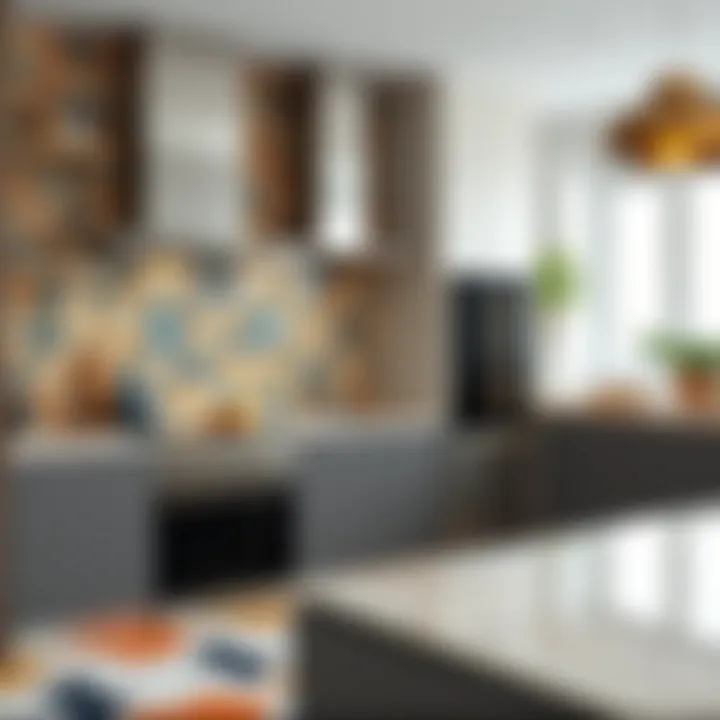
Ceramic tiles are among the most prevalent choices for kitchen spaces, and for good reason. They are made from clay and then kiln-fired to harden, creating a durable surface. One of the standout features of ceramic tiles is their versatility in design. They come in a multitude of colors, patterns, and finishes, allowing homeowners to match them with various kitchen styles—be it rustic, modern, or something in between.
Beyond their aesthetic appeal, ceramic tiles are also relatively easy to maintain, as they are resistant to moisture and staining. However, they can be prone to cracking if subjected to heavy impact, so caution is advised in busy kitchens.
Porcelain Tiles
Porcelain tiles often give ceramic a run for its money, especially when it comes to strength and water resistance. Made from denser clay and fired at higher temperatures, porcelain tiles present a tougher facade that stands up well against foot traffic and spills. Traditionally available in simpler designs, they now come in an array of styles and colors, even mimicking the look of natural stones or wood.
Their low porosity also means they resist stains and moisture effectively, making them a favorable option for kitchens. However, the solid structure can make installation more challenging, requiring professional tools and expertise to achieve the best results.
Natural Stone Tiles
While natural stone tiles have an undeniable elegance, they introduce a different set of considerations. Comprising materials such as granite, marble, travertine, and slate, each brings its own unique texture and appearance to the kitchen. The character of natural stone is unparalleled, often embodying beautiful variances in color and pattern.
Yet, they come with a caveat: many types of natural stone require regular sealing to guard against stains and water damage. They can also be more costly and may necessitate more involved installation processes to ensure proper alignment and support.
Glass Tiles
Glass tiles, while not as common, offer a modern touch that can truly elevate kitchen spaces. Their reflective surfaces can magnify light, adding a sense of openness and airiness to the room. Available in a spectrum of colors and finishes, glass tiles can be used as accents or full wall coverings.
One essential aspect to remember when using glass tiles is their fragility. They can chip or crack more easily than their ceramic counterparts, so they’re best suited for areas that won't see heavy usage. Nonetheless, when properly used, they can create stunning visual effects in the kitchen.
Vinyl Tiles
Lastly, we can’t overlook vinyl tiles, which have gained traction for their affordability and ease of installation. Available in sheets, planks, or tiles, the material offers an extensive range of patterns and colors which can replicate more luxurious materials at a fraction of the cost.
While vinyl tiles are resistant to scratches and stains, they can sometimes be less durable than other options, particularly in high-traffic areas. Homeowners should expect a shorter lifespan and be aware of the potential to fade over time.
"Selecting tile material isn’t just about looks; it’s about choosing the best fit for your lifestyle and kitchen use."
In summary, understanding different tile materials arms you with the knowledge necessary to make informed decisions for your kitchen design. Each tile type has its strengths and weaknesses, and considering factors such as durability, maintenance, and style will ensure a satisfying investment for years to come.
Popular Tile Patterns for Kitchens
When it comes to refining the heart of the home, tile patterns hold a significant place. They not only add aesthetic appeal but also contribute to the overall functionality of the kitchen. Choosing the right pattern can enhance small spaces, blend styles, and even impact a homeowner's daily experience in this beloved area. Each pattern tells its own story, expressing personal taste while also serving practical needs. For instance, certain patterns may make a smaller kitchen feel more expansive, while others can create a cozy, inviting atmosphere. Let's dive into some common yet captivating tile patterns that can dramatically elevate your kitchen’s look.
Subway Tiles
Subway tiles have emerged as a classic choice in contemporary kitchen design. Characterized by their rectangular shape, they are often used to create uniform and linear appearances. Typically, these tiles are installed in a staggered pattern resembling a brick layout, which can inject a certain dynamism into the ambiance.
One of the significant benefits of subway tiles is their versatility. Not only do they mesh well with various styles, be it rustic, modern, or even industrial, but they also come in countless colors and finishes. It’s this adaptability that allows homeowners to customize their space without overwhelming the senses. Plus, they are relatively easy to clean, making them a surefire winner for those who value practicality as well as aesthetic appeal.
Herringbone Pattern
Moving on to herringbone, this pattern is both eye-catching and unique. It features rectangular tiles arranged at 45-degree angles to create a zigzag design. The herringbone pattern adds a sense of movement to any kitchen and has a way of drawing the eyes around the space.
Using this pattern can enhance dramatic effects, particularly in larger kitchens. It’s quite popular for back splashes or even for entire walls, providing a strong focal point. However, one should consider that installation can be more complex than simpler designs, requiring a keen eye for alignment and spacing. This complexity can increase the labor costs for installation but often pays off in the form of an impressive visual statement.
Chevron Design
Similar to herringbone, the chevron design features a V-shaped layout made from angled tiles. Unlike herringbone, chevron tiles are cut at an angle, giving off a seamless continuation of the pattern. This design can evoke a sense of modernity and elegance, making it a prime choice for upscale kitchen renovations.
The chevron pattern is particularly striking with bold colors or unique textures. For instance, a glossy black or white chevron tiled backsplash can serve as a stunning contrast against wooden cabinetry. This style is ideal for homeowners looking to create an impactful and trendsetting design that doesn’t shy away from making a statement.
Mosaic Patterns
Mosaic patterns bring a unique charm that transforms the kitchen into a canvas of color and creativity. Composed of small individual tiles or pieces, often in different colors, these patterns can embody various styles from classic to avant-garde. The beauty of mosaics lies in their customizability; homeowners can select colors that resonate with their personal style and fits the overall kitchen theme.
Mosaics not only provide an artistic flair but can also serve functional purposes. For example, intricate designs in a low-traffic area can minimize wear and tear while creating visual interest. However, it’s vital to keep in mind that maintaining the grout lines in such layouts can require regular attention to keep them looking fresh and vibrant.
Grid Layout
Finally, the grid layout is perhaps the simplest yet often overlooked of tile patterns. This uniform design involves square tiles laid out in straight lines, creating a clean and orderly appearance. While it may lack the elaborate flair of herringbone or mosaic designs, its simplicity can complement various kitchen styles without overwhelming other design elements.
Utilizing a grid layout can help promote a sense of balance and symmetry in the kitchen. It pairs well with vivid colors and can also create a backdrop for eye-catching countertop materials or cabinetry. Plus, installation and maintenance are relatively straightforward, making it a pragmatic option for busy households.
Color Schemes and Their Impact
Color is not just about aesthetics in kitchen design; it plays a critical role in shaping the ambiance and functionality of the space. When it comes to tile patterns, the color scheme can significantly influence how a kitchen feels. From creating the illusion of space to evoking warmth and comfort, the right colors can make a world of difference. Understanding these dynamics can help homeowners and design enthusiasts make choices that are not only visually appealing but also enhance the overall experience of the kitchen.
Monochromatic Designs
Monochromatic designs offer a simple yet sophisticated approach. By using variations of a single hue, such as different shades of blue, it brings a sense of cohesion to the kitchen. This approach allows for a serene environment that can feel quite calming, especially in spaces where one spends a lot of time cooking and entertaining.
Choosing a monochromatic tile pattern, like light blue wall tiles paired with deeper blue flooring, can create a seamless look. Additionally, accents of white or gray can prevent the design from becoming stagnant, maintaining interest through texture rather than overwhelming color shifts.
Bold Contrasts
In contrast, bold color schemes can really make a statement. Utilizing opposing colors, such as bright red tiles against a stark black countertop, can create an eye-catching focal point within the kitchen. This design choice not only ignites energy in the cooking space but can also highlight architectural elements, like arches or cabinetry.


The interaction between contrasting colors can stimulate the visual senses, proving beneficial for those who love vibrant atmospheres. However, it’s important to strike a balance; too many opposing colors can clash, causing discord rather than harmony. The trick is to make sure there’s a unifying element—perhaps through similar materials or finishes—that ties the design together.
Earthy Tones
For those drawn to nature, earthy tones can ground the kitchen in warmth and authenticity. Colors such as terracotta, sage green, and muted browns not only evoke a rustic flair but also blend well with various kitchen styles, from farmhouse to modern minimalist.
When tiles in earthy shades are combined with wooden or stone elements, they can create a connection between the interior space and the outdoors. The subtle visual texture of these colors offers a comfortable and welcoming vibe, making the kitchen feel like the heart of the home.
A warm beige tile pattern on the floor can beautifully complement dark wooden cabinetry, providing depth without overwhelming the senses.
The choice of color for kitchen tiling goes far beyond mere decoration; it's an essential component that influences mood, style, and functionality.
Selecting the right color scheme is a strategic decision that reflects personal style while enhancing the kitchen's practicality. Homeowners and design aficionados should always keep in mind how these colors interact with light and space to achieve the best possible design outcome.
Integrating Tile Patterns with Kitchen Layouts
When it comes to kitchen design, one of the pivotal aspects often overlooked is how tile patterns harmonize with the layout of the space. The right tile can not only enhance the aesthetic appeal but also contribute significantly to the functionality of your kitchen. Integrating tile patterns effectively elevates your culinary space, bringing it to life while offering practical advantages, from ease of cleaning to creating visual flow. In this section, we will explore how different kitchen layouts interact with tile design, highlighting the benefits and factors to consider.
Open Concept Kitchens
Open concept layouts are the gold standard in modern homes, favoring a free-flowing design that connects kitchen, dining, and living areas. Selecting tiles for such spaces requires an eye for continuity and cohesion. The idea is to create a seamless transition between zones. Large-format tiles can work wonders here, minimizing grout lines and making spaces feel expansive. For a more dynamic touch, consider using a contrasting pattern on a kitchen island that delineates it from the surrounding areas.
Key Benefits of Tile in Open Concept Designs:
- Visual Continuity: Tiles in similar hues can unify separate areas, even when the functions differ.
- Durability: Open spaces see high foot traffic. Tiles stand the test of time, offering longevity.
- Easy Cleaning: Tiles, particularly those with a smooth finish, are simple to maintain, making them ideal for a busy family environment.
Galley Kitchens
Galley kitchens, characterized by their narrow and elongated design, are often equipped with a functional layout that maximizes efficiency. Choosing tiles for this style can be a game changer, allowing you to trick the eye and make the space feel larger. Horizontal tile patterns can elongate the appearance of walls, drawing the eye along the length of the galley. Play with textures too; adding a matte finish to the lower tiles can create a subtle contrast with glossy ones above, enhancing visual appeal.
Considerations When Tiling in Galley Kitchens:
- Tile Orientation: The direction of tiles can have a remarkable effect on space perception.
- Color Choices: Light colors can illuminate narrow areas, while dark shades can add drama, if used wisely.
- Area Specifics: Use different tiles in high-use zones, like around the stove or sink, to ensure durability and functionality.
L-Shaped Kitchens
The L-shaped kitchen layout offers more room to play with tile patterns since it encompasses different working zones, like cooking and washing. Tiles can be used to distinguish these functional areas while maintaining an overall cohesive look. For instance, you might opt for a striking mosaic behind the cooktop to serve as a focal point while choosing a more understated tile for the rest of the kitchen. This layered approach not only emphasizes the different zones but also encourages creativity without overwhelming the senses.
Potential Challenges and Tips for L-Shaped Kitchens:
- Balancing Patterns: When using varied tile patterns, it’s essential to strike a balance. Too many contrasts can be jarring.
- Functional Design: Ensure that tiles are not slippery, particularly in the cooking and washing areas, to enhance safety.
"Successful integration of tile patterns with kitchen layouts is key to optimizing space while establishing a unique character for the kitchen."
Maintenance and Care for Kitchen Tiles
Keeping kitchen tiles spick and span is crucial, not just for aesthetics but also for longevity and hygiene. Kitchen spaces are often bustling with activity, leading to spills, stains, and grime accumulation. Maintenance and care for kitchen tiles is not a one-time affair; it's a continuous commitment that pays off significantly in the long term. Understanding which tiles you have and the best practices for caring for them can enhance their appearance and preserve their life.
Regular maintenance ensures that dirt doesn’t settle in and become a headache down the line. Stains on tiles can be challenging to remove if allowed to sit too long. Ignoring basic care could lead to tiles fading or cracking. Plus, clean tiles contribute to a healthier environment, reducing allergens and bacteria that can accumulate.
It’s not just about wiping down surfaces; it’s about adopting a routine that safeguards your investment. Here are two vital aspects of tile care that every homeowner should consider:
Cleaning Techniques
When it comes to cleaning kitchen tiles, the methods you choose will depend on the material:
- Ceramic and Porcelain: These hardy tiles require straightforward care. Use a mixture of warm water and mild detergent. A microfiber mop can effectively lift dirt without leaving streaks, making it a go-to tool. For stubborn stains, consider a paste of baking soda and vinegar, but test it in a discreet area first to ensure it doesn't damage the finish.
- Natural Stone Tiles: Stone is porous and often requires a specialized cleaner to prevent discoloration. Avoid acidic cleaners like lemon juice or vinegar, as they can etch the surface. Instead, get a pH-neutral cleaner designed specifically for stone. Wipe up spills immediately to prevent staining.
- Glass Tiles: It’s best to stick with soft cloths that won't scratch the surface. A mix of water and a few drops of vinegar can keep glass tiles sparkling but don’t saturate them, or you might cause water damage over time.
Tip: No matter the type of tile you have, always follow the manufacturer's recommendations regarding cleaning products and techniques.
Preventative Measures
Prevention is always better than cure, and that's particularly true for kitchen tile care. Here are some steps to keep your tiles looking pristine:
- Seal Grout Lines: Grout tends to absorb stains more rapidly than tiles. Regularly sealing your grout can prevent stains and make it easier to clean. Re-sealing every three to six months can help maintain its integrity.
- Use Mats and Rugs: Place mats near sink areas and entryways to catch spills and dirt before they get to your floors. Not only do they help keep tiles clean, but they can also add a bit of style to your kitchen.
- Act Quickly on Spills: The faster you act, the less likely spills will leave a stain. Always keep a cloth handy for minor accidents.
Adopting a few simple habits can save you time, stress, and money while ensuring your kitchen remains the beautiful heart of your home for years to come.
"An ounce of prevention is worth a pound of cure." – Benjamin Franklin
By maintaining your tiles with effective cleaning techniques and preventative measures, you’re ensuring that your kitchen remains a welcoming and stylish space. For more tips on tile care, you can check out resources at TileSizer or visit The National Tile Contractors Association.
Your kitchen should not just be functional but also reflect who you are, and a commitment to tile care is a step toward achieving that vision.
Budget Considerations for Tile Installation
When embarking on a kitchen renovation, it's essential to keep a keen eye on the budget. Proper planning and understanding the financial breakdown related to tile installation can make your kitchen dreams come true without breaking the bank. Tile patterns can transform any kitchen; however, the costs involved can vary significantly from one project to another. Here we’ll delve into the key aspects of costs associated with tile installation, covering materials, labor, and timeframes, to help you make informed decisions.
Cost of Materials
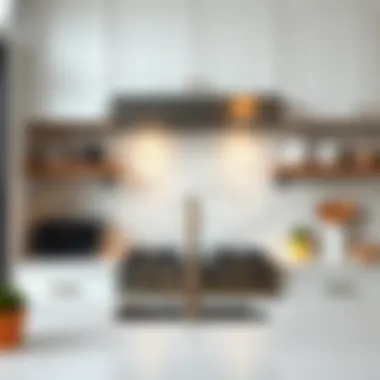
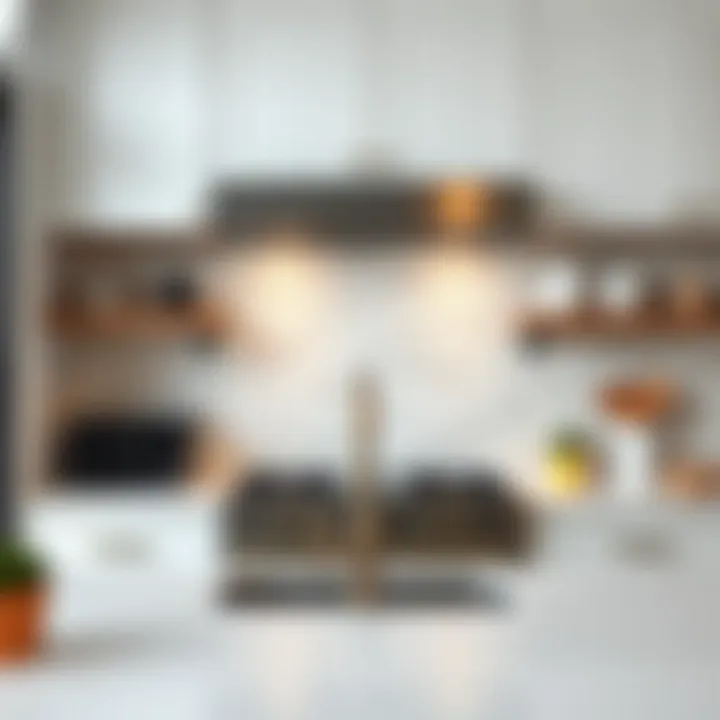
One of the first things to consider when setting your budget is the cost of materials. Tile varieties range from economical choices like vinyl to premium options such as natural stone or artisan ceramics. The price per square foot can differ widely based on the material.
- Ceramic Tiles: These are often the most affordable, typically ranging from $1 to $5 per square foot. They are durable and come in a multitude of styles.
- Porcelain Tiles: Slightly more expensive, porcelain may cost between $3 to $10 per square foot due to its ability to withstand moisture better than regular ceramics.
- Natural Stone Tiles: If you are aiming for elegance, natural stone like granite or marble could be a way to go, but expect to pay anywhere from $5 to over $15 per square foot.
- Glass Tiles: Known for their beauty, glass tiles can also be pricey, hitting the $7 to $30 per square foot range, based on design and quality.
- Vinyl Tiles: As a budget-friendly option, vinyl can cost as low as $0.50 to $3 per square foot.
Important Note: Always factor in extra costs for special finishes or patterns, as intricate designs often require precise cutting and additional materials.
Labor Costs
Labor can account for a hefty chunk of the overall budget for tile installation. Hiring professionals can save time and ensure that the job is done right, but it comes at a cost. Understanding the nuances can lead to significant savings.
A few points to consider when assessing labor costs include:
- Hourly Rates vs. Flat Fees: Many contractors charge by the hour, typically $40 to $100 per hour, while others might provide a flat fee based on the scope of the project.
- Complexity of Installation: If your tile layout requires complex cuts, custom patterns, or intricate designs, expect labor costs to increase accordingly.
- Geographical Differences: Rates can vary based on your location. Urban areas often have higher labor costs compared to rural areas.
Taking the time to get quotes from multiple contractors will help ensure you get a competitive rate, and don’t shy away from asking for references and seeing examples of their prior work.
Timeframe for Installation
Understanding the timeframe for installation is crucial as it can impact both your budget and daily life. A quick turnaround can be tempting, but rushing often leads to costly mistakes.
- Preparation: Depending on the existing floor, preparation can take a few hours to a couple of days. Removing old flooring and making necessary repairs can require additional time, affecting the overall cost if not planned in advance.
- Installation Time: For conventional tile layouts, you might expect a day or two for a standard sized kitchen. Intricate designs, like herringbone or custom mosaics, could stretch that timeframe to several days if not weeks.
- Curing Time: Post-installation, remember to factor in drying or curing time, especially when using grout or adhesives, as this can delay your return to normal kitchen activities.
DIY vs. Professional Installation
When it comes to kitchen tile installation, homeowners often grapple with the decision between tackling the project themselves or hiring a professional. This choice can substantially impact both the aesthetics and functionality of the space. The pros and cons of each method demand careful consideration, as they involve not only cost factors but also the potential outcomes of the installation process.
Pros and Cons of DIY
Taking on a tile installation project yourself can be quite appealing for a multitude of reasons. Here are some of the positive and negative aspects of going the DIY route:
Pros:
- Cost Savings: One of the most immediate benefits is the potential savings on labor costs. This can free up a chunk of the budget to splurge on higher-quality tiles or additional features.
- Personal Satisfaction: Completing a project can provide a sense of accomplishment. The pride in knowing you did it your way can be fulfilling.
- Control Over Project Timeline: When you handle the installation, you set the schedule. There are no delays due to professional availability or other commitments.
Cons:
- Skills and Experience: Without the right expertise, the final result might not meet your expectations. Tile installation is a skilled trade, and mistakes can be glaring.
- Time-Consuming: Learning the ropes of tiling can be slow, especially if you have limited experience. A task that might be simple for a pro could take a lot longer for you.
- Potential for Errors: There’s always the risk of miscalculations, which can lead to additional costs in both materials and time, making the project less economical than initially anticipated.
Advantages of Hiring Professionals
Choosing to bring in professional help can be a game-changer in the realm of kitchen tile installation. Here’s why many homeowners opt for experts:
- Expertise in Installation: Professionals possess the skills honed through experience. They’re well-versed in techniques that ensure tiles are laid correctly, ensuring longevity.
- Design Insight: Many professionals offer design consultations. They can help you choose patterns and colors that align with your vision while maintaining practicality.
- Efficiency in Execution: A team with experience can often finish the job much more quickly than a DIY effort. This means less disruption to your kitchen, a vital part of the home.
- Warranties and Guarantees: Hiring pros often comes with the peace of mind that work is guaranteed. If something goes wrong, you have recourse through their warranty policies.
Ultimately, the decision between DIY and professional installation hinges upon one’s comfort level, budget constraints, and overall vision for the kitchen. While doing it yourself can offer savings and pride, the security and expertise of professionals can result in outcomes that elevate a kitchen’s functionality and aesthetic significantly. It's all about weighing your options wisely.
The Future of Kitchen Tile Design
In the realm of home design, kitchens often take center stage due to their functionality and aesthetic importance. As we look forward, tile design in kitchens is no exception, evolving to meet the demands of modern living. The future of kitchen tile design reflects not just shifts in style but also innovative materials and sustainability practices that resonate with a more eco-conscious clientele. By understanding upcoming trends and sustainability considerations, homeowners and design enthusiasts can more effectively plan and execute their kitchen projects with tiles that are not only beautiful but also practical and responsible.
Emerging Trends
The kitchen tile landscape is seeing an array of emerging trends that promise to reshape the aesthetic and practical dynamics of kitchen spaces. Some noteworthy trends include:
- Textured Surfaces: In the past, smooth and glossy finishes reigned supreme. However, a newfound appreciation for tactile design is leading many to explore various textures. Textured tiles can add depth and interest to the kitchen, breaking the monotony commonly associated with flat surfaces.
- Bold Patterns and Colors: The days of predominantly neutral palettes may be numbered as designers and homeowners alike embrace bolder colors and intricate patterns. Expect to see vibrant hues and artistic designs, making tiles do the heavy lifting in terms of personal expression in a kitchen's design scheme.
- Large Format Tiles: The trend of larger tiles continues to gain traction, offering fewer grout lines and a seamless look. This not only makes for easier maintenance but creates an illusion of space, which can be especially beneficial in smaller kitchens.
- Mixing Materials: Combining different tile types and styles within the same space has become more prevalent. This eclectic approach allows for personalization and can result in striking designs that stand out.
- Smart Tiles: As technology infiltrates every aspect of life, smart tiles are on the horizon. Imagine tiles that react to temperature changes, display information, or are equipped to aid in cooking. Though still in the early stages, the potential is vast.
These trends indicate a shift toward artistic expression and innovative functionality, setting the stage for kitchens that reflect a more personalized vision.
Sustainability Considerations
Sustainability is often a guiding principle in today’s design choices, and kitchen tiles are no different. As eco-conscious living gains momentum, several considerations arise:
- Recycled Materials: Many manufacturers are now creating tiles from recycled materials, reducing waste while providing homeowners with unique design options. Tiles made from reclaimed wood, recycled glass, or even porcelain can provide distinct character with a lesser environmental footprint.
- Low Emission Products: The use of low-VOC (Volatile Organic Compound) tiles is becoming increasingly popular. These tiles help maintain better indoor air quality, which is essential in a space that hosts a plethora of activities.
- Durability and Longevity: Investing in high-quality tiles that stand the test of time is not just a stylish choice but a sustainable one. Durable materials reduce the need for frequent replacements, which, in turn, minimizes waste.
- Natural Materials: Increasingly, consumers are gravitating toward natural stone and other organic materials. These tiles not only bring a timeless aesthetic but also often have a smaller environmental impact compared to synthetic alternatives.
"Sustainable choices today pave the way for healthier homes and a planet in the long run."
By considering these sustainability aspects, homeowners are not only enhancing their kitchen's elegance but also contributing positively to the environment. The future of kitchen tile design is not solely about what looks good but how that beauty aligns with a more sustainable lifestyle.
The End: Choosing the Right Tile Pattern
Selecting the right tile pattern for a kitchen is akin to choosing the right outfit for a special occasion—it must not only look appealing but also fit well into the lifestyle of those who will inhabit the space. Throughout this article, we navigated the intricate world of kitchen tile patterns by exploring diverse materials, styles, and the practicalities of installation. Each choice carries its weight, and it all starts with understanding personal preferences and the requirements of the kitchen.
In today's world, where kitchens often serve as the heart of the home, the visual appeal must be harmonized with functionality. A successful tile pattern can enhance the overall aesthetics of the kitchen while simultaneously providing durability and ease of maintenance. Just think about the first time you step into a well-tiled kitchen; it speaks volumes about the design sensibility and care taken in the home's renovation or construction.
Key Elements to Consider
- Style Compatibility: When selecting tiles, consider the overall decor of the kitchen. Do you lean towards a modern, minimalist vibe or a cozy, rustic feel? Subway tiles might work wonders in a contemporary setting, while natural stone could add warmth to a more traditional kitchen.
- Color Scheme: The color of the tiles should complement the cabinetry and countertops. A smart mix of earthy tones can create a relaxing atmosphere, while a bold color contrast might energize the space. Balancing these hues is crucial for achieving a cohesive design.
- Tile Size and Shape: Larger tiles can create an illusion of space in a small kitchen, but smaller tiles might be better for intricate patterns like mosaics. The shape of the tiles also matters—rectangular vs. square tiles lead to different layouts and impressions.
- Maintenance Requirements: Understand the cleaning and upkeep associated with your chosen materials. For instance, glass tiles may add elegance but could require more care to maintain their shine compared to ceramic tiles.
"Tile patterns are more than mere decoration; they encapsulate the homeowner's personality and lifestyle."
By weighing these factors carefully, one can select a tile pattern that meets not only aesthetic needs but also practical considerations for everyday use. This blend of beauty and functionality allows homeowners to create spaces that are truly reflective of their individual style while being welcoming and practical for daily living.
For more information on tile design trends, consult reputable resources such as Wikipedia, Britannica, or relevant home improvement forums on Reddit.
Let your kitchen reflect who you are; make that tile pattern a true conversation starter.







